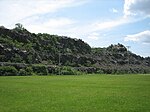WNYC (AM)

WNYC (820 AM) is a nonprofit, non-commercial, public radio station licensed to New York City. The station is owned by New York Public Radio along with sister stations WNYC-FM and Newark, New Jersey-licensed classical music outlet WQXR-FM (105.9 MHz). It is a member of NPR and carries local and national news/talk programs. Some programming is simulcast on WNYC-FM and at other times different programming airs on each station. WNYC broadcasts from studios and offices located in the Hudson Square neighborhood in lower Manhattan, and its transmitter site is located in Kearny, New Jersey. WNYC has been an early adopter of new technologies including HD radio, live audio streaming, and podcasting. RSS feeds and email newsletters link to archived audio of individual program segments. WNYC makes all of its programming available on the WNYC app.
Excerpt from the Wikipedia article WNYC (AM) (License: CC BY-SA 3.0, Authors, Images).WNYC (AM)
New Jersey Turnpike Eastern Spur,
Geographical coordinates (GPS) Address Nearby Places Show on map
Geographical coordinates (GPS)
| Latitude | Longitude |
|---|---|
| N 40.752777777778 ° | E -74.104166666667 ° |
Address
New Jersey Turnpike Eastern Spur
07096
New Jersey, United States
Open on Google Maps








